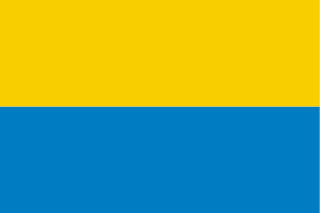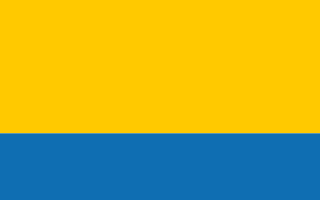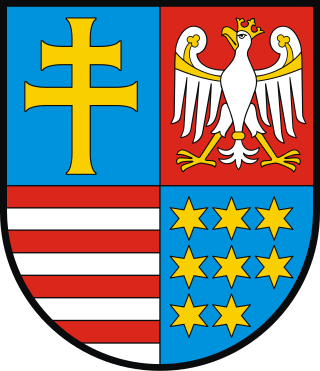
The flag of the city of Warsaw, the capital of Poland, is a bicolour rectangle, divided into two equally-sized horizontal stripes: yellow at the top, and red at the bottom. It began being used in 1938 without official status, and was officially adopted by the city, in 1991.

The civil flag of the Lublin Voivodeship, Poland is a tricolour rectangle, with three horizontal stripes: white (silver), red, and yellow (golden), with the coat of arms of the voivodeship, in form of the white (silver) malejumping cervus, with a yellow (golden) crown on its neck, placed on the red escutcheon, placed in the centre of the flag. The cervus is facing left. The top and bottom stripes are twice the size of the middle stripe.

The flag of the exclave of Kaliningrad Oblast is a rectangle with a ratio of 2:3 divided into three horizontal stripes. The upper stripe is red, a thin yellow stripe in the middle and a dark blue stripe of the same size as the red bar. In the canton is a silver-and-black stylized medieval castle with open gates and the monogram of Empress Elizabeth Petrovna.

The coat of arms of the Lesser Poland Voivodeship, Poland features a white (silver) eagle with a yellow (golden) crown on his head that is turned left, a beak, legs, and a stripes on its wings, with the charge placed on the red background. It was designed by Wojciech Drelicharz, Zenon Piech, and Barbara Widłak, and adopted in 1999.

The flag that serves as the symbol of the historical and geographical regions of the Silesia, and Lower Silesia, and as one of the symbols of the Silesian people, is divided horizontally into two stripes: white on the top and yellow on the bottom. It originated as the flag of the Province of Silesia, used from 1882 to 1919, that later used as the flag of the Province of Lower Silesia, from 1920 to 1935. Currently, the flag is recognized symbol of the Silesian people in the state of Saxony in Germany.

The flag that serves as the symbol of the historical and geographical region of the Upper Silesia, and as one of the symbols of the Silesian people, is divided horizontally into two stripes: yellow on the top and blue on the bottom. It originated as the flag of the Province of Upper Silesia adopted in 1920, with its colours based on the coat of arms of Upper Silesia. The flag is also popular symbol used by the Silesian Autonomy Movement.

The flag of the Kuyavian-Pomeranian Voivodeship, Poland is a tricolour rectangle, with three horizontal stripes: red, white, and black, with white stripe in the middle being twice the size of the other ones.

The flag of the Podlaskie Voivodeship, Poland is a rectangle divided into four horizontal stripes, that are, from the top to bottom: white, red, yellow, and blue. It was designed by Tadeusz Gajl, and adopted on 30 August 2002.

The civil flag of the Silesian Voivodeship, Poland is triband rectangle, divided into three horizontal stripes, that are from top to bottom: blue, yellow, and blue. The blue stripes are twice the size of the yellow middle stripe. The state flag is a blue rectangle with yellow eagle placed in its centre. It was designed by Barbara Widłak, and adopted on 11 June 2001.

The flag of the West Pomeranian Voivodeship, Poland is a triband rectangle, divided vertically in 3 stripes of white, red, and white colour, and with the coat of arms of the voivodeship in the middle. It was adopted in 2000.

The flag of the Lower Silesian Voivodeship, Poland, is a yellow (golden) rectangle with the left-faced black eagle, with a white (silver) crescent-shaped przepaska put across its wings, with a white (silver) cross pattée on top of it, in its middle.

The civil flag of the Lubusz Voivodeship, Poland is a rectangle divided into 4 stripes, which are, from top to bottom, yellow (golden), white, (silver), red, and green. Top and bottom stripes are twice the size of the 2 middle stripes. The state flag features the design of the civil flag, with the coat of arms of the voivodeship placed in the centre. It was adopted on 26 June 2000.

The civil flag of the Łódź Voivodeship, Poland is a rectangle divided into five vertical stripes, which are altering between red and yellow colours. It was designed by Marek Adamczewski, and officially adopted on 25 June 2002.

The civil flag of the Opole Voivodeship, Poland is a rectangle divided into two horizontal stripes, with yellow on the top, and blue at the bottom. The top stripe is twice the size of the bottom one.

The coat of arms of the Łódź Voivodeship, Poland is an Iberian-style escutcheon with square top and rounded base. It is divided horizontally into three stripes (pales), that area from left to right: yellow (golden), red, and yellow (red), with the middle stripe being twice as big as the other stripes. It also include three charges placed in its center, with two placed next to each over, on the top of the third one. The top two charges are Kuyavian Hybrids, divided into half, into a lion and an eagle, while the bottom one is an eagle. It was designed by Marek Adamczewski, and officially adopted on 25 June 2002.

The flag of the Świętokrzyskie Voivodeship, Poland is a rectangle divided into four parts. Its left part features a yellow vertical stripe, which wight equals to 1:4 of the wight of the flag. Its right part is divided into three horizontal stripes, that are, from top to bottom: blue, white, and red. In the middle of the white stripe is placed the coat of arms of the voivodeship. The first version of the flag had been adopted in 2001, and current version is used since 2013.

The flag that serves as the symbol of the historical and geographical region of the Western Pomerania is divided horizontally into two stripes: light blue on the top and white on the bottom. It originated as the flag of the Province of Pomerania, Prussia, used from 1882 to 1935. Since 1996, it is officially recognized as the symbol of the historical region of Western Pomerania within Mecklenburg–Western Pomerania, Germany.

The coat of arms that serves as the symbol of the Świętokrzyskie Voivodeship, Poland, consists of the Iberian style escutcheon (shield), with square top and rounded base, that is divided in the 2 by 2 chessboard pattern. The top left field features a yellow patriarchal cross. The top right field features a white eagle with yellow crown, beak, legs, stripes on its wings, and a ring on its tail. The bottom left field features eight yellow six-pointed starts, placed in three rows, each with three stars, with the exception of the bottom row, that only had 2 stars, placed to the left.

The coat of arms of Dęblin, Poland depicts a depicts the Eagle of Zeus, in form of a light gray (silver) eagle, which holds a yellow (golden) globe from which emerge four lightning bolts, placed on a blue field. The flag of Dęblin is divided into three horizontal stripes, that are white, yellow, and blue, with the top and the bottom stripes are twice the size of the middle stripe. They are, from top to bottom, white, yellow, and blue. The current town symbols were introduced in 1993, and designed by Dariusz Dessauer. The original town coat of arms was introduced in 1974.



















